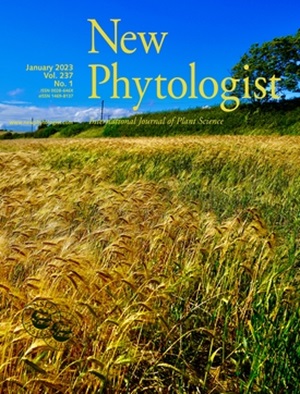Pine-fungal co-invasion alters whole-ecosystem properties of a native eucalypt forest.
IF 8.1
1区 生物学
Q1 PLANT SCIENCES
引用次数: 0
Abstract
Pine-fungal co-invasions into native ecosystems are increasingly prevalent across the southern hemisphere. In Australia, invasive pines slowly spread into native eucalypt forests, creating novel mixed forests. We sought to understand how pine-fungal co-invasions impact interconnected above- and belowground ecosystem characteristics. We sampled beneath mature Pinus radiata and Eucalyptus racemosa in a pine-invaded eucalypt forest in New South Wales, Australia. We measured microbial community composition via amplicon sequencing of 16S, ITS2, and 18S rDNA regions, microbial metabolic activity via Biolog plate substrate utilization, and soil, leaf litter, and understory plant characteristics. Pines were associated with decreased topsoil moisture, increased pine litter, and decreased eucalypt litter total phosphorus content. Soils and roots beneath pines had distinct microbial community composition and activity relative to eucalypts, including decreased bacterial diversity, decreased microbial utilization of several C- and N-rich substrates, and enrichment of pine-associated ectomycorrhizae. Introduced suilloid fungi were abundant across both pine and eucalypt soils and roots. Many ecosystem impacts increased with pine size. Invasive pines and their ectomycorrhizae have significant impacts on eucalypt forest properties as they grow. Interconnected impacts at the scale of individual trees should be considered when managing invaded forests and predicting effects of pine invasions.松真菌的共同入侵改变了原生桉树林的整个生态系统特性。
在南半球,松真菌对本地生态系统的共同入侵越来越普遍。在澳大利亚,入侵的松树慢慢蔓延到当地的桉树林中,形成了新的混交林。我们试图了解松真菌共同入侵如何影响相互关联的地上和地下生态系统特征。在澳大利亚新南威尔士州的松树入侵桉树林中,我们在成熟的辐射松和总状桉树下进行了采样。我们通过16S, ITS2和18S rDNA区域的扩增子测序,通过Biolog板底物利用以及土壤,凋落叶和林下植物特征来测量微生物群落组成。松林降低了表层土壤水分,增加了松林凋落物,降低了桉树凋落物全磷含量。与桉树相比,松树下土壤和根系的微生物群落组成和活性明显不同,包括细菌多样性减少,微生物对几种富C和富n基质的利用减少,以及松树相关外生菌根的富集。在松木和桉树的土壤和根系中,引入的水蛭真菌都很丰富。许多生态系统影响随着松树的大小而增加。入侵松树及其外生菌根对桉树林的生长有显著的影响。在管理入侵森林和预测松树入侵的影响时,应考虑个体尺度上的相互影响。
本文章由计算机程序翻译,如有差异,请以英文原文为准。
求助全文
约1分钟内获得全文
求助全文
来源期刊

New Phytologist
生物-植物科学
自引率
5.30%
发文量
728
期刊介绍:
New Phytologist is an international electronic journal published 24 times a year. It is owned by the New Phytologist Foundation, a non-profit-making charitable organization dedicated to promoting plant science. The journal publishes excellent, novel, rigorous, and timely research and scholarship in plant science and its applications. The articles cover topics in five sections: Physiology & Development, Environment, Interaction, Evolution, and Transformative Plant Biotechnology. These sections encompass intracellular processes, global environmental change, and encourage cross-disciplinary approaches. The journal recognizes the use of techniques from molecular and cell biology, functional genomics, modeling, and system-based approaches in plant science. Abstracting and Indexing Information for New Phytologist includes Academic Search, AgBiotech News & Information, Agroforestry Abstracts, Biochemistry & Biophysics Citation Index, Botanical Pesticides, CAB Abstracts®, Environment Index, Global Health, and Plant Breeding Abstracts, and others.
 求助内容:
求助内容: 应助结果提醒方式:
应助结果提醒方式:


